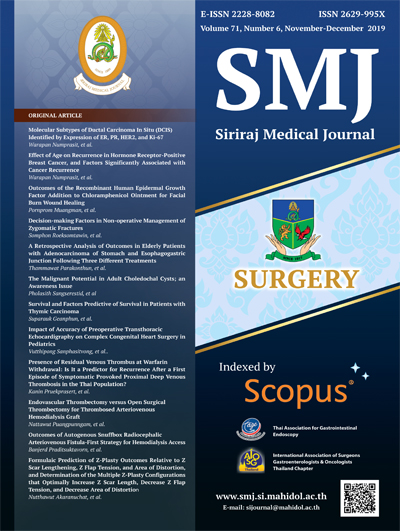Survival and Factors Predictive of Survival in Patients with Thymic Carcinoma
DOI:
https://doi.org/10.33192/Smj.2019.70Keywords:
Thymic carcinoma; malignant thymoma; invasive mediastinal tumorAbstract
Objective: Thymic carcinoma is a rare malignancy that has a poor prognosis and low 5-year survival. The rarity of this disease and the variety of histologic subtypes has limited the evidence needed to establish disease-specific staging and treatment guidelines. The aim of this study was to investigate overall survival, the factors that predict survival, and the treatment modalities that influence survival in patients with thymic carcinoma.
Methods: All thymic carcinoma cases diagnosed and treated at Siriraj Hospital (Bangkok, Thailand) during 1997-2013 were retrospectively reviewed. Univariate and multivariate analyses were performed to identify factors that predict survival, and overall survival was estimated by Kaplan-Meier method.
Results: Of the 45 patients diagnosed during the study period, 8 were lost to follow-up. The remaining 37 patients were included in our analysis. The median survival time was 2.5 years, with 5-year and 10-year survival of 40% and 16%, respectively. In univariate analysis, tumors >10 cm (p=0.017), high-grade histologic subtypes (p=0.014), and high Masaoka stage (p=0.011) were significant determinants of survival. Multivariate analysis revealed tumor size (HR: 3.594, 95% CI: 1.103-11.714; p=0.034) and high-grade histologic subtypes (HR: 8.175, 95% CI: 1.689-39.566; p=0.009) to be independent predictors of survival. Patients who underwent tumor removal had significantly longer median survival time than those who didn’t (3.85 vs. 0.63 years; p=0.005).
Conclusion: Thymic carcinoma patients have low 5-year and 10-year survival. Tumor size and high-grade histologic subtype were identified as independent predictors of survival, and surgical therapy was found to be significantly associated with longer median survival time.
Downloads
Published
How to Cite
Issue
Section
License
Authors who publish with this journal agree to the following conditions:
Copyright Transfer
In submitting a manuscript, the authors acknowledge that the work will become the copyrighted property of Siriraj Medical Journal upon publication.
License
Articles are licensed under a Creative Commons Attribution-NonCommercial-NoDerivatives 4.0 International License (CC BY-NC-ND 4.0). This license allows for the sharing of the work for non-commercial purposes with proper attribution to the authors and the journal. However, it does not permit modifications or the creation of derivative works.
Sharing and Access
Authors are encouraged to share their article on their personal or institutional websites and through other non-commercial platforms. Doing so can increase readership and citations.















